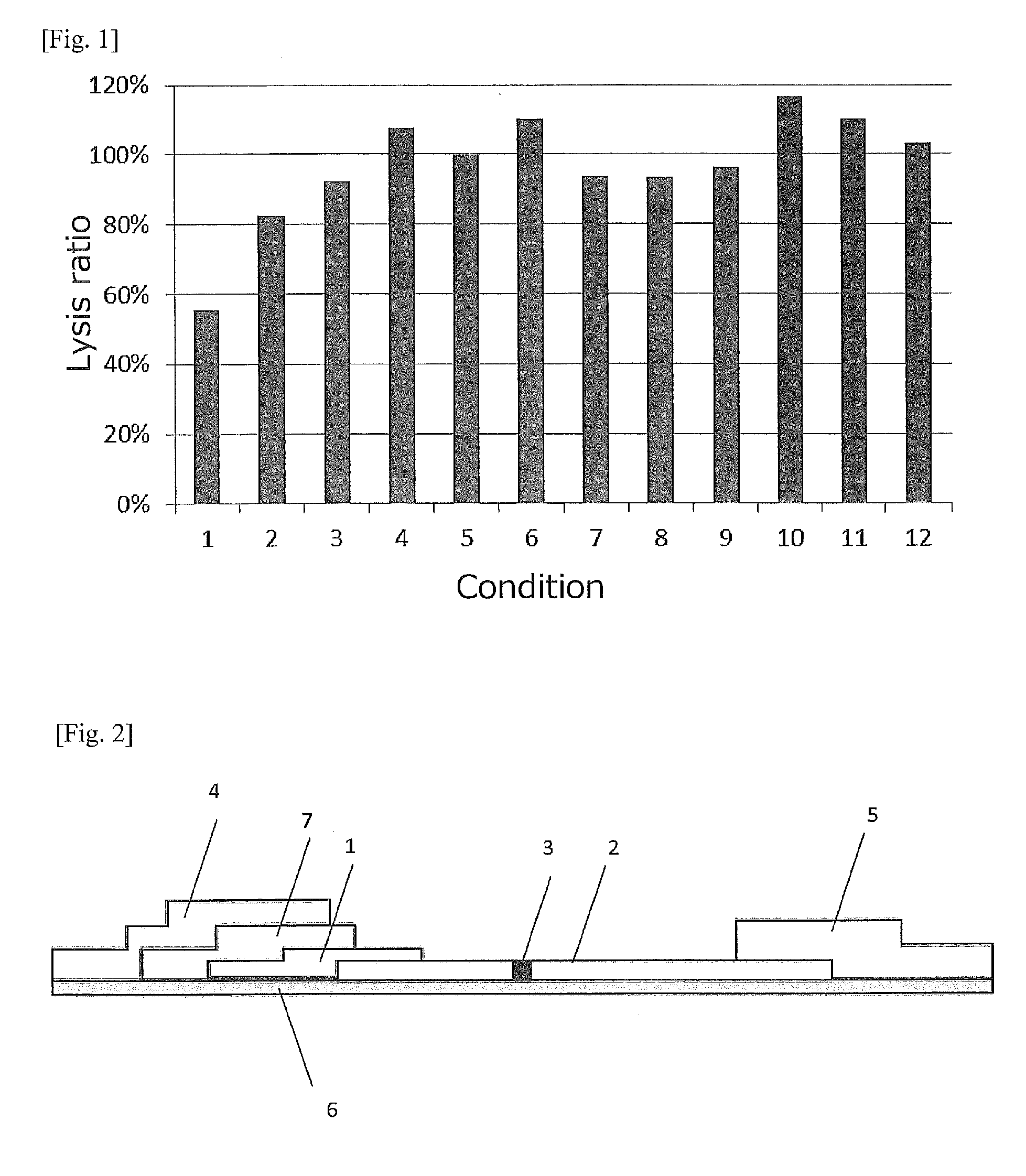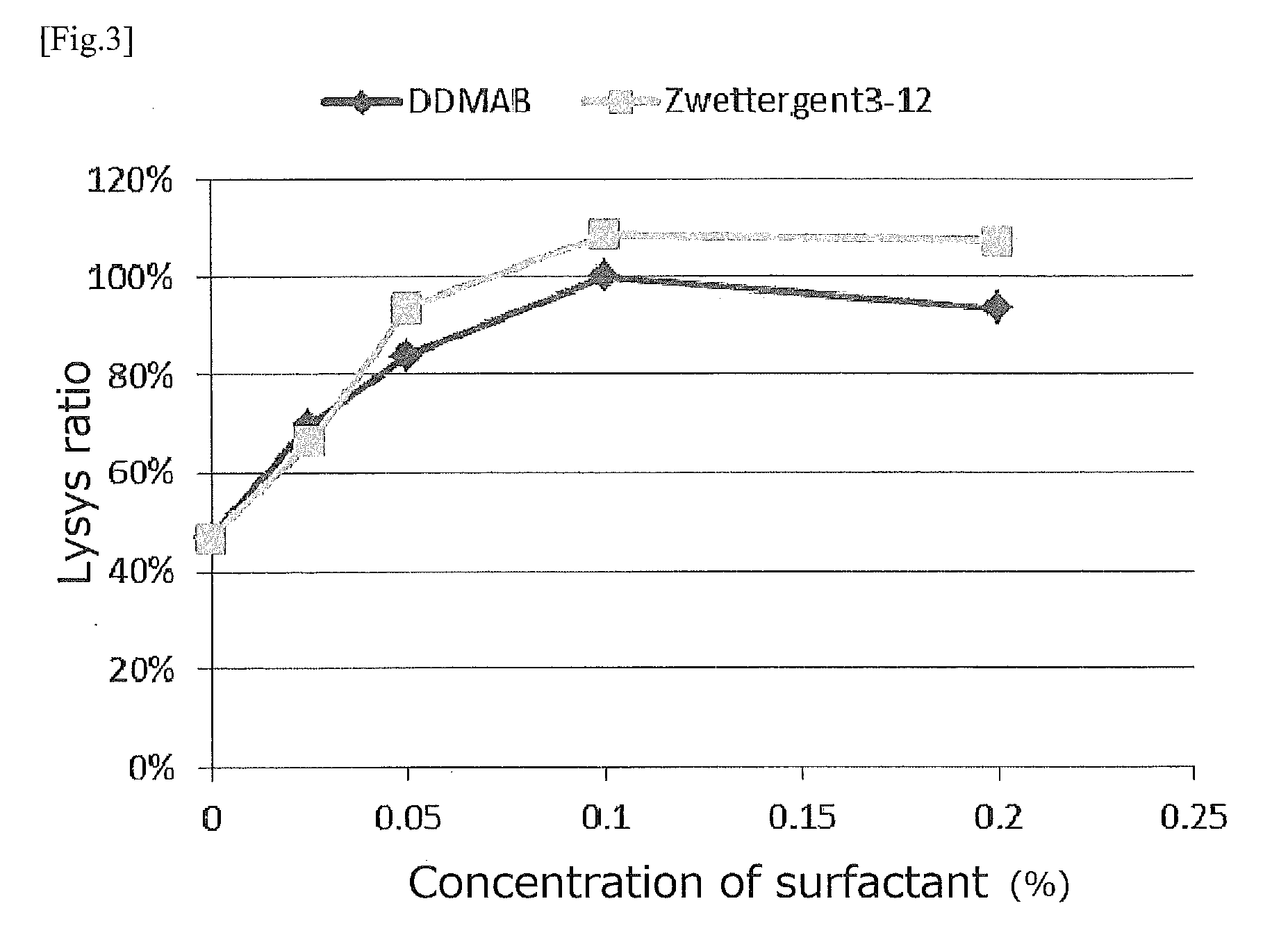Method for detecting staphylococcus contained in milk
a staphylococcus and detection method technology, applied in the field of lysis method and detection method for detecting a staphylococcus, can solve the problems of insufficient lysis in many cases, several days to obtain, etc., and achieve the effect of fast, convenient and highly sensitive detection on the spo
- Summary
- Abstract
- Description
- Claims
- Application Information
AI Technical Summary
Benefits of technology
Problems solved by technology
Method used
Image
Examples
example 1
Effect of Ampholytic Surfactant in the Presence of Lytic Enzyme and Nonionic Surfactant in Detection of Staphylococcus aureus by Enzyme Immunoassay (ELISA)
(a) Preparation of Monoclonal Antibody Directed To Ribosomal Protein L7 / L12
[0103]As the antibody to be labeled with gold colloid, Staphylococcus aureus ribosomal protein L7 / L12 monoclonal antibody was used. According to the method described in International Patent Publication WO00 / 06603, Example 5, the Staphylococcus aureus L7 / L12 ribosomal protein was obtained, and monoclonal antibodies were prepared by using this protein. Among the monoclonal antibodies, a combination of two kinds of monoclonal antibodies (SA-1 and SA-2) that can simultaneously bind to different sites of the aforementioned L7 / L12 ribosomal protein was selected.
(b) Confirmation of Effect of Lytic Enzyme in ELISA
[0104]Effect of the lytic enzyme was confirmed as follows.
[0105]The monoclonal antibody SA-1 (10 μg / ml) and PBS (100 μl) were put into each well of a 96-w...
example 2
Effect of Ampholytic Surfactant in the Presence of Lytic Enzyme and Nonionic Surfactant in Detection of Staphylococcus aureus by Immunochromatographic Method
(1) Preparation of Immunochromatographic Device
[0108]An immunochromatographic device was prepared as follows.
(a) Gold Colloid-Labeled Antibody-Impregnated Member
[0109]A gold colloid solution (particle size 60 nm, 0.9 mL, BB International) was mixed with 0.1 M potassium phosphate, pH 7.0, the monoclonal antibody SA-2 (100 μg / mL) to be labeled with gold colloid was added to the mixture, and the resulting mixture was left standing at room temperature for 10 minutes so that the antibody bound to the gold colloid particle surfaces. Then, a 10% aqueous solution of bovine serum albumin (BSA) was added at a final concentration of 1% in the gold colloid solution, so that the remaining surfaces of the gold colloid particles were blocked with BSA, to prepare a solution of the monoclonal antibody SA-2 labeled with gold colloid (henceforth r...
example 3
Measurement in Milk Sample by Immunochromatographic Method
[0115]An immunochromatographic method was performed for a milk sample obtained from a cow with mastitis. The measurement was performed in the same manner as that of Example 2 (lysis treatment solution contained 1% (final concentration) of Tween 20, 10 μg / ml (35 units / ml) of lysostaphin, 0.1 M MOPSO, pH 7.5, 0.1% (final concentration) of Zwettergent 3-12, the treatment was performed at room temperature for 30 minutes, and the development was performed at room temperature for 30 minutes), and the appeared reddish purple line was visually examined (positive +, negative −). Separately, in order to confirm the number of Staphylococcus aureus in the milk, quantification was performed by the cultivation-based method. Each milk sample (100 μl) was inoculated to Trypticase Soy Agar II with 5% Sheep Blood (Becton Dickinson Japan), then incubation was performed at 37° C. for 24 hours, and the colonies that appeared were counted. The num...
PUM
| Property | Measurement | Unit |
|---|---|---|
| concentration | aaaaa | aaaaa |
| concentration | aaaaa | aaaaa |
| concentration | aaaaa | aaaaa |
Abstract
Description
Claims
Application Information
 Login to View More
Login to View More - R&D
- Intellectual Property
- Life Sciences
- Materials
- Tech Scout
- Unparalleled Data Quality
- Higher Quality Content
- 60% Fewer Hallucinations
Browse by: Latest US Patents, China's latest patents, Technical Efficacy Thesaurus, Application Domain, Technology Topic, Popular Technical Reports.
© 2025 PatSnap. All rights reserved.Legal|Privacy policy|Modern Slavery Act Transparency Statement|Sitemap|About US| Contact US: help@patsnap.com


